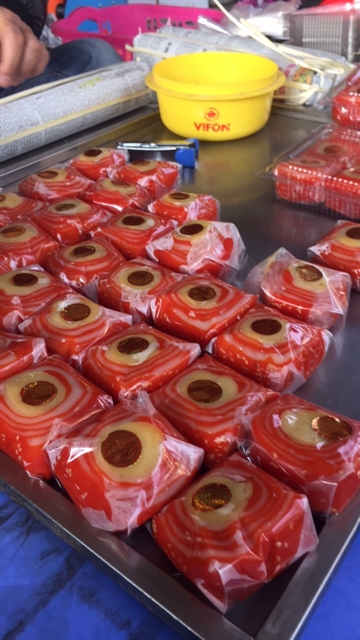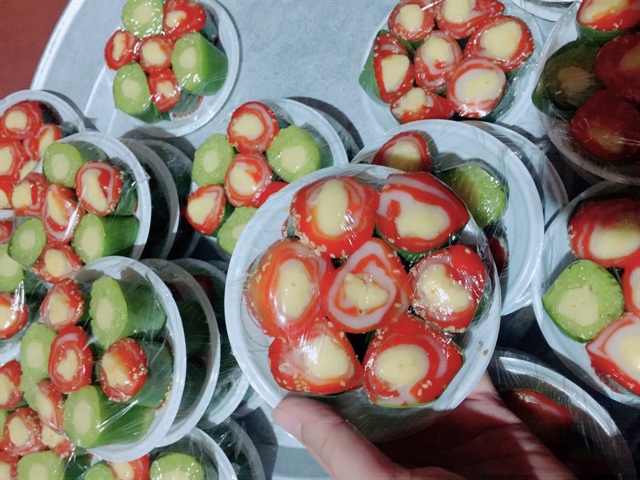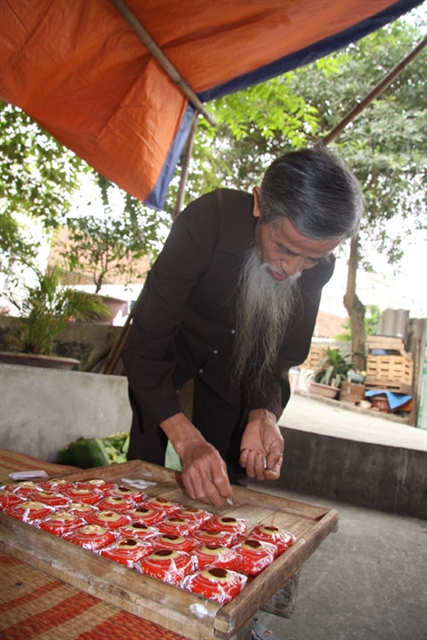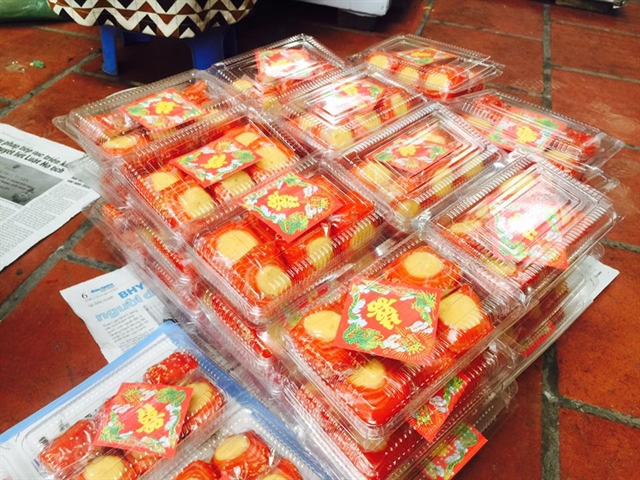Nguyễn Thanh Hà
HÀ NỘI — Giang Xá Village in Hà Nội’s Hoài Đức District is famous for the delightful bánh bác (fried cake made from sticky rice, gấc fruit and green bean), a delicacy which has existed for more than a hundred years.
Eighty-year-old bánh bác artisan Đỗ Phú Phủ said that in the past, Lý Bí, whose native village was in Sơn Tây Province (now part of Hà Nội), followed his Zen teacher to settle at Linh Bảo Pagoda in Giang Xá Village where he grew up and led an insurrection to fight the Liang aggressors from China to establish the Vạn Xuân, the first state of Việt Nam. He was crowned as King Lý Nam Đế.
During his reign (503-548), locals created the cake to offer it to the king.

Bánh bác (fried cake made from sticky rice, gấc fruit and green bean), Việt Nam’s only specialty made by Giang Xá villagers in Hà Nội’s Hoài Đức District. — Photo Nguyễn Hải.
“For us, the cake is the village’s symbol. In the past, it expressed our respect and sentiment to the king and in the present, it reflects our soul and culture of our village,” Phủ said, adding that initially, the cake was only made by village elders but years later, they handed down the job to their descendants to make the cake for village festivals, wedding ceremonies or precious gifts for guests.
Asked why the cake is called bác, Phủ said “It is a local proper name. Although it is made by frying, our ancestors did not call it bánh rán but bánh bác because we use our hands to fry it on a cast iron pan instead of using chopsticks.”
Phủ said to have a tasty tày (locally known as a big bác cake about 50cm in length and 10cm in diameter), a maker has to carefully choose ingredients such as nếp cái hoa vàng (special sticky rice grown in Giang Xá Village), gấc (a type of perennial melon) fruit, green beans, brown sugar, pork loin fat, banana leaves and bamboo strings.
The sticky rice is soaked in warm water for 2-3 hours before being ground into a wet powder then divided it into two halves, one used to mix with gấc fruit, and the other left to remain in white, said Phủ.

Locals display the red bác cakes alternating with green cakes to worship King Lý Nam Đế on his birthday and death anniversaries. — Photo Nguyễn Hải.
The most important steps are to knead the wet powder for it to become plastic and fry it on a cast iron pan by hand.
“I have to use my hands to fry the cake by spreading the powder as thin as possible on the pork loin fat pan over medium fire which should use longan wood to ensure the cake’s original fragrance,” he said.
The last step is to wrap the cake by alternating mixing the gấc fruit cake and the white cake then put sugar mixed with boiled and ground green bean inside these layers on banana leaves then tie it with bamboo strings, said Phủ, adding that it needs five to six hours to make such a tày cake.
“When I was young, my father taught me how to make the cake, I had to suffer severely heat on my hands while frying the cake. I once thought I could give up the job but my father encouraged me a lot, saying I should try my best to preserve the job and hand it down to our younger generations.

Bác cake artisan Đỗ Phú Phủ arranges his cakes to be readily sent to customers in HCM City. — Photo banhbaclanggiangxa.com
“My father said it is the pride of our village,” Phủ said.
Each tày bác cake can be cut into 10 pieces.
“Each piece looks like a beautiful flower with red colour from gấc fruit, white colour from sticky rice powder and brown-yellow colour of green beans,” Phủ said.
Đặng Thị Thất from central Hà Nội recently bought the cake to offer to her future daughter-in-law’s family as engagement gift and said she was interested in the cake because of its colour and aromatic flavour.
“The cake has a fragrance of sticky rice, light sweet of gấc fruit and buttery taste of green beans mixed with sugar," said Thất.

The colourful cakes packed in boxes to be ready for sale. — Photo Nguyễn Hải.
Phạm Tuấn Hải, former judge of Việt Nam Master Chef, said there are no localities in Việt Nam with such a cake so the Giang Xá people should try to preserve it as a national specialty. — VNS
OVietnam